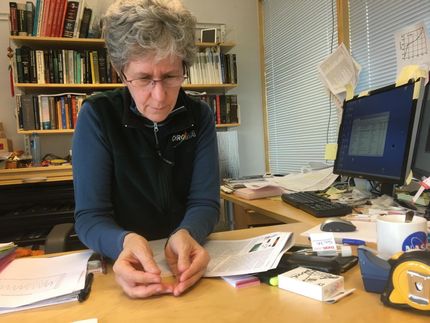Germanium made laser compatible
Microprocessors communicating with light
Advertisement
Researchers from ETH Zurich, the Paul Scherrer Institute (PSI) and the Politec-nico di Milano have jointly developed a manufacturing technique to render the semiconductor germanium laser-compatible through high tensile strain. In their article they reveal how they can gen-erate the necessary tensile strain efficiently. The scientists demonstrate how to use their method to effectively alter the optical properties of germanium, which is naturally unsuitable for lasing: "With a strain of three per cent, the material emits around twenty-five times more photons than in a relaxed state," explains Martin Süess, a doctoral student at the Laboratory for Nanometallurgy headed by Ralph Spolenak and the EMEZ at ETH Zurich. "That's enough to build lasers", adds his colleague Richard Geiger, a doctoral student at the Laboratory for Micro- and Nanotechnology at the PSI and the Institute for Quantum Electronics at ETH Zurich under Jérôme Faist.
High tension through microbridges
With the new method, the researchers use the slight tension generated in ger-manium when it evaporates on silicon, to bring the germanium into a laser-compatible, strechted form. This prestrain is enhanced with so-called micro-bridges: the researchers centrally notch the sides of exposed germanium strips, which remain attached to the silicon layer at both ends. The two halves of the strip thus remain connected solely by an extremely narrow bridge, which is for physical reasons precisely where the strain in the germanium grows so intense that it becomes laser-compatible.
"The tensile strain applied to the germanium is comparable to the force exerted on a pencil as two lorries pull upon it in opposite directions," says Hans Sigg, the project manager at the PSI, explaining the feat on a micrometre scale in everyday proportions. Through the expansion of the material its properties change because the individual atoms slightly move apart, which enables the electrons within the material to reach energy levels that are favourable for the generation of light particles, so-called photons.
Germanium laser for the computer of the future
The interdisciplinary research team's method could increase the performance of future computer generations considerably. After all, in order to improve comput-er performance, computer chips have constantly been made smaller and more densely packed. However, this approach will eventually reach its limits in the foreseeable future. "In order to further increase performance and speed, the individual components need to be linked more closely and communicate with each other more efficiently," explains Süess. This requires new transmission paths that are faster than today, where the signals are still transmitted via elec-tricity and copper cables.
"The future way to go is light," says Geiger. However, in order to be able to use light to transfer data, first of all light sources are needed that are so small as to fit onto a chip and react well to silicon, the base material of all computer chips. Silicon itself is not suitable for the emission of laser light, which is also the reason why it is so important for the researchers to make germanium laser-compatible: "Germanium is perfectly compatible with silicon and already used in the computer industry for the production of silicon chips," explains Geiger. If it is possible to build tiny lasers out of germanium using the new method, a system change is within reach. "We're on the right track," says Süess. The international team of researchers is currently in the process of actually constructing a germa-nium laser with the new method.





























































